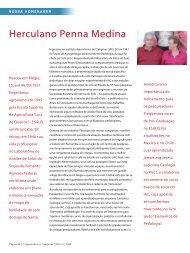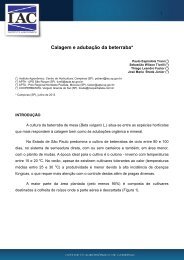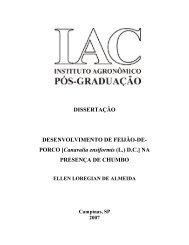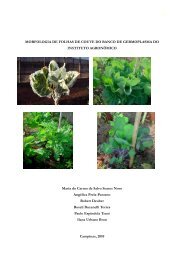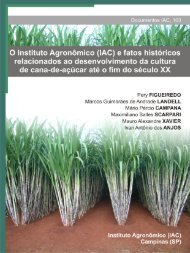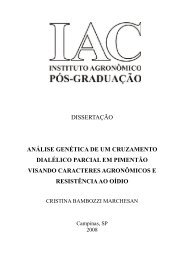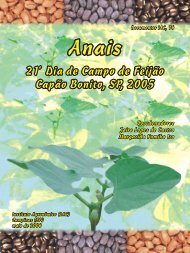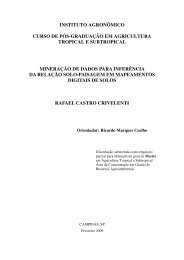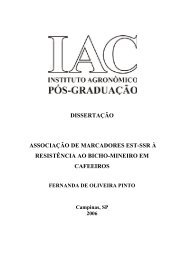vi seminário sobre pragas, doenças e plantas daninhas do ... - IAC
vi seminário sobre pragas, doenças e plantas daninhas do ... - IAC
vi seminário sobre pragas, doenças e plantas daninhas do ... - IAC
- No tags were found...
Create successful ePaper yourself
Turn your PDF publications into a flip-book with our unique Google optimized e-Paper software.
ABSTRACT<br />
BEAN GENOTYPES REACTION TO Xanthomonas axonopodis pv. phaseoli. Common bean (Phaseolus<br />
vulgaris L.) is an important culture in Brazil and the country is the biggest producer and consumer of<br />
bean. Common bean blight, caused by Xanthomonas axonopodis pv. phaseoli (Smith) Dye, is the main<br />
bacterial disease in bean culture and presents ample distribution, causing serious losses in the production.<br />
The objective of this work was to evaluate the reaction of bean genotypes to X. axonopodis pv. phaseoli.<br />
Twenty five bean genotypes of <strong>IAC</strong> germplasm bank were evaluated, for the artificial inoculation in primary<br />
leaves through multiple needles method. For evaluation, a note scale was used from 1 to 5 (Sugimori &<br />
Oliveira, 1996), being 1 = without symptoms in the inoculated area, Immune (I); 2 = soaked point of<br />
inoculation, Resistant (R); 3 = soak up 20% around the points of inoculation, Moderately Resistant (MR);<br />
4 = soak and/or necrosis of inoculated area, Susceptible (S) and 5 = leaf soak and necrosis and appearance<br />
of symptoms outside inoculated area, Highly Susceptible (HS). The evaluation was carried out between<br />
seven and 10 days after inoculation. The notes varied between 2 and 5. The genotypes LP 01.38 and LP<br />
98 122 were R. The genotype IAPAR 31, was MR. The genotypes BRS Grafite, BRS Requinte, CV 48,<br />
Gen 96 A1473153v2, Gen 96 A3 P1.1.1, Gen 96 A98 5.1.1.55, Gen 96 A100 6-1-53-1, Gen 99 TGR 31-14,<br />
<strong>IAC</strong>-Carioca Tybatã, <strong>IAC</strong>-Una, LP 99 79, Pérola and Z28 were S. The genotypes BRS Triunfo, FT Nobre,<br />
Gen 96 A98 13-152-1, Gen 99 TG 28-28, Gen 99 TG 3950, Gen 99 TGR 1-10, Gen 99 TGR 60-9, Jalo<br />
Precoce and Rosinha G2 were HS. It was concluded that the bean genotypes LP 01.38 and LP 98 122 are<br />
resistants to X. axonopodis pv. phaseoli, and are good sources of resistance for use in bean genetic<br />
improvement programs.<br />
Key words: Common bean blight, bean, resistance sources.<br />
1. INTRODUÇÃO<br />
O feijoeiro comum (Phaseolus vulgaris L.) é a espécie mais cultivada entre as demais <strong>do</strong><br />
gênero Phaseolus, destaca-se dentre as principais culturas <strong>do</strong> país, sen<strong>do</strong> o Brasil um <strong>do</strong>s maiores<br />
produtores mundiais e consumi<strong>do</strong>r dessa leguminosa.<br />
Apesar de apresentar destaque na produção mundial de feijão, a produti<strong>vi</strong>dade brasileira é<br />
muito baixa. O Brasil, na safra de 2004/2005, apresentou uma produção de 3.045.600 t, com<br />
produti<strong>vi</strong>dade de 773 kg.ha -1 (Conab, 2006), valor muito aquém <strong>do</strong> potencial genético da cultura, que<br />
pode atingir acima de 4.500 kg ha -1 .<br />
Entre as principais causas da baixa produti<strong>vi</strong>dade da cultura estão as <strong>do</strong>enças (Bianchini et<br />
al., 1997; Sartorato et.al., 2005). O crestamento bacteriano comum, causa<strong>do</strong> por Xanthomonas<br />
axonopodis pv. phaseoli (Smith) Dye, é a principal <strong>do</strong>ença bacteriana na cultura <strong>do</strong> feijoeiro (Ito et<br />
al., 1997; Bianchini et al., 1997; Sartorato et al., 2005) e apresenta ampla distribuição, ocasiona<br />
graves perdas na produção, especialmente em regiões úmidas, com temperaturas de moderadas a<br />
altas (Rava, 2005). As perdas são ocasionadas pela redução da área foliar fotossinteticamente ativa,<br />
de<strong>vi</strong><strong>do</strong> à formação de manchas encharcadas nas folhas, que posteriormente originam extensas<br />
áreas necrosadas.<br />
O méto<strong>do</strong> ideal de controle <strong>do</strong> crestamento bacteriano comum é o uso de cultivares resistentes,<br />
porém há deficiência na oferta de material comercial aos produtores de feijão.<br />
Documentos, <strong>IAC</strong>, Campinas, 79, 2007<br />
190



